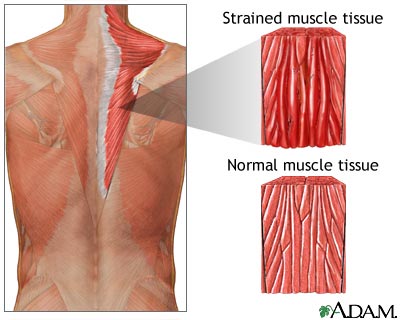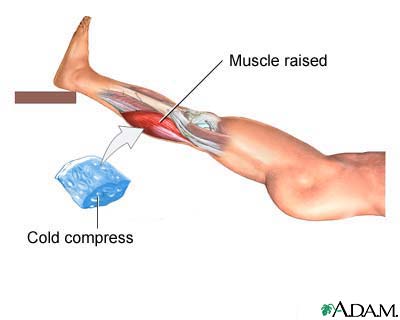Health Library
Strains
Pulled muscle
A strain is when a muscle is stretched too much and tears. It is also called a pulled muscle. A strain is a painful injury. It can be caused by an accident, overusing a muscle, or using a muscle in the wrong way.
Images


I Would Like to Learn About:
Causes
A strain may be caused by:
- Too much physical activity or effort
- Improperly warming up before a physical activity
- Poor flexibility
Symptoms
Symptoms of a strain can include:
- Pain and difficulty moving the injured muscle
- Discolored and bruised skin
- Swelling
First Aid
Take the following first aid steps to treat a strain:
- Apply ice right away to reduce swelling. Wrap the ice in cloth. Do not place ice directly on the skin. Apply ice for 10 to 15 minutes every 1 hour for the first day and every 3 to 4 hours after that.
- Use ice for the first 3 days. After 3 days, either heat or ice may be helpful if you still have pain.
- Rest the pulled muscle for at least a day. If possible, keep the pulled muscle raised above your heart.
- Try not to use a strained muscle while it is still painful. When the pain starts to go away, you can slowly increase activity by gently stretching the injured muscle.
When to Contact a Medical Professional
Call your local emergency number, such as 911, if:
- You are unable to move the muscle.
- The injury is bleeding.
Call your health care provider if the pain does not go away after several weeks.
Prevention
The following tips may help you reduce your risk of a strain:
- Warm-up properly before exercise and sports.
- Keep your muscles strong and flexible.
References
Biundo JJ. Bursitis, tendinitis, and other periarticular disorders and sports medicine. In: Goldman L, Schafer AI, eds. Goldman-Cecil Medicine. 26th ed. Philadelphia, PA: Elsevier; 2020:chap 247.
Wang D, Eliasberg CD, Rodeo SA. Physiology and pathophysiology of musculoskeletal tissues. In: Miller MD, Thompson SR. eds. DeLee, Drez, & Miller's Orthopaedic Sports Medicine. 5th ed. Philadelphia, PA: Elsevier; 2020:chap 1.
Geiderman JM, Katz D. General principles of orthopedic injuries. In: Walls RM, Hockberger RS, Gausche-Hill M. Rosen's Emergency Medicine: Concepts and Clinical Practice. 9th ed. Philadelphia, PA: Elsevier; 2018:chap 42.
BACK TO TOPReview Date: 5/3/2021
Reviewed By: Linda J. Vorvick, MD, Clinical Associate Professor, Department of Family Medicine, UW Medicine, School of Medicine, University of Washington, Seattle, WA. Also reviewed by David Zieve, MD, MHA, Medical Director, Brenda Conaway, Editorial Director, and the A.D.A.M. Editorial team.
 | A.D.A.M., Inc. is accredited by URAC, for Health Content Provider (www.urac.org). URAC's accreditation program is an independent audit to verify that A.D.A.M. follows rigorous standards of quality and accountability. A.D.A.M. is among the first to achieve this important distinction for online health information and services. Learn more about A.D.A.M.'s editorial policy, editorial process and privacy policy. A.D.A.M. is also a founding member of Hi-Ethics. This site complies with the HONcode standard for trustworthy health information: verify here. |
The information provided herein should not be used during any medical emergency or for the diagnosis or treatment of any medical condition. A licensed medical professional should be consulted for diagnosis and treatment of any and all medical conditions. Links to other sites are provided for information only -- they do not constitute endorsements of those other sites. © 1997- 2021 A.D.A.M., a business unit of Ebix, Inc. Any duplication or distribution of the information contained herein is strictly prohibited.
